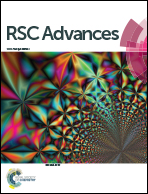Dual-functional anticoagulant and antibacterial blend coatings based on gemini quaternary ammonium salt waterborne polyurethane and heparin†
Abstract
Complications such as thromboembolism and bacterial infection, arising from the widespread use of implanted medical devices, are serious problems for current clinical treatment. In this work, dual-functional anticoagulant and antibacterial blend coatings were designed and fabricated from gemini quaternary ammonium salt waterborne polyurethane (GWPU) emulsion and heparin aqueous solution. The results demonstrate that the L-lysine-derivative gemini quaternary ammonium salt (GQAS) in GWPU endows the coating with excellent non-releasing antibacterial ability and simultaneously the release of heparin provides superior anticoagulant activity. Moreover, the controlled release of heparin is achieved by the ionic interaction between the positive charge in GQAS and the negative charge in heparin. On the basis of the dual-functional anticoagulant and antibacterial properties of GWPU/heparin blend coatings, this work proposes a facile strategy to achieve syncretic performances in biomaterials, and these coatings would have the potential to improve the application of implanted devices.


 Please wait while we load your content...
Please wait while we load your content...